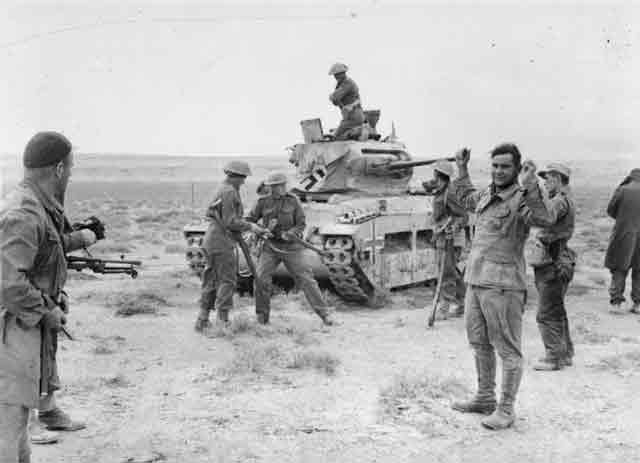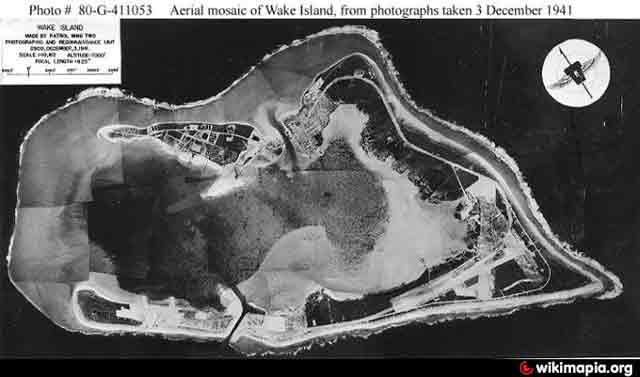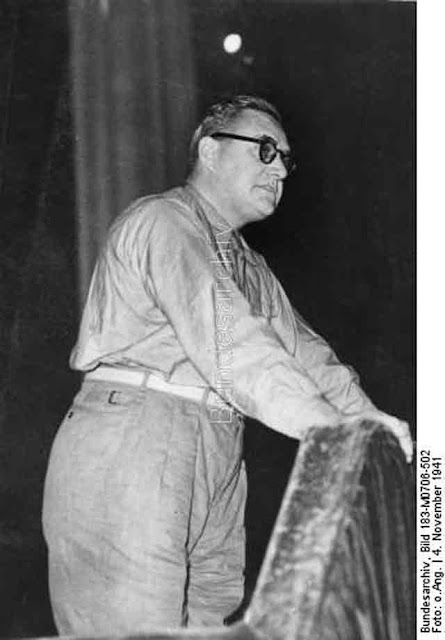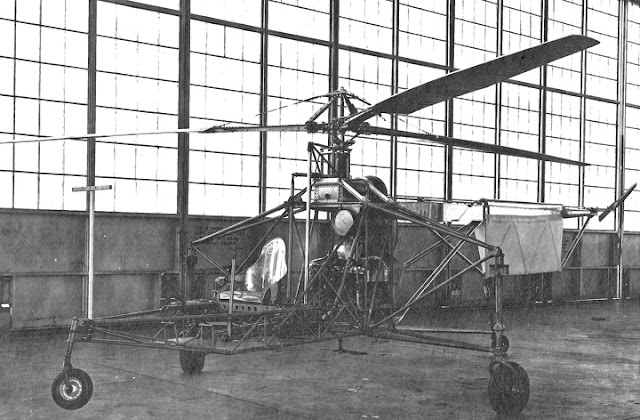Wednesday 3 December 1941
 |
| German soldiers who had captured a British Matilda tank and were using it to cross Allied lines are captured by New Zealand troops on 3 December 1941. They have painted a Balkencreuz (straight-armed cross) and Swastika on the tank, which makes them prisoners - without the markings, they could be shot as spies. |
Eastern Front: The waning German offensive against Moscow continues to show just enough indications that it is succeeding on
3 December 1941 for some generals to continue supporting it. However, doubts are growing daily. Today, Fourth Army commander Field Marshal Hans von Kluge, who is not known for challenging orders (he is known as "kluge Hans," or clever Hans, for his slippery demeanor), asks Field Marshal Fedor von Bock for permission to end the offensive. Bock himself also has doubts, but he tells von Kluge to wait a few days to see if things improve.
 |
| "HMS GLASGOW, while acting as escort to a convoy carrying troops, steamed close by and played her band for them." 3 December 1941. © IWM (A 6789). |
The day's events on the battlefield, however, are not promising. The German 258th Infantry Division, which scored an unexpected breakthrough in recent days to the west of the Soviet capital, is surrounded and has to fight its way out to the west. To the northwest, at Yakhroma, Third Panzer Army is making no progress against the First Shock Army. South of Moscow, a blizzard hits during a German attack by the 3rd and 4th Panzer Divisions along with Grossdeutschland and the panzers manage to cut the Tula-Serpukhov-Moscow Highway and also sever the Tula-Moscow rail line near Revyakino. It is small advances like this that give the Wehrmacht some confidence that its decision to continue attacking is the right one - even though the gains are minor and isolated.
 |
| The Soviet transport "Josif Stalin," engaged in the evacuation of Hanko, Finland on 3 December 1941, has its bow blown off and sinks after running into the Corbetha minefield in the Gulf of Finland. While the men on board appear calm, most are about to die. About 4000 of the nearly 6000 men on board perish. Once you are in the icy water in your winter gear, you die quickly. |
The retreat from Rostov-on-Don ordered by General Ewald von Kleist in the southern section of the front appears to have worked in preserving the German forces there. As OKH operations chief General Franz Halder notes in his war diary:
In Army Group South, enemy pressure only against our combat outposts on the southern wing; on other portions of the Front, the enemy is moving closer to the rearguards still forward of the new position [the Mius River line]. The enemy may still be preparing a major concentration of forces opposite the Italian Corps. Railroad movements, possibly troops, from Stalingrad.
If nothing else, this entry is interesting for its mention of Stalingrad. The retreat from Rostov that cost Field Marshal Gerd von Rundstedt his position as commander of the Army Group. One thing is for certain: the Red Army always has more troops to throw into the mix all along the front, and not just at Moscow.
 |
| Jawaharlal Nehru, shown here in prison, is released on 3 December 1941 from Dehradun Jail. He was jailed on 21 October 1940 by the British and sentenced to four years' "Rigorous Imprisonment" for anti-government activities. |
Battle of the Mediterranean: The day begins with both sides believing that they have the upper hand on the very fluid fighting that has resulted from the British Operation Crusader. The British and New Zealand forces, for the most part, have been pushed back but not defeated. The Germans do, at least temporarily, retain the initiative. General Erwin Rommel has sent the Geissler Advance Guard and the Knabe Advanced Guard battalion groups to the southeast in order to reestablish contact with isolated German garrisons along the border. However, the 5th New Zealand Brigade stops the Geissler advance on the Bardi road near Monastir and sends it reeling, while the Knabe battalion advancing toward Capuzzo ends in a standoff with the Central India Horse reconnaissance regiment "Goldforce." Rommel is undeterred by these setbacks and orders a resumption of the Afrika Korps attack for 4 December.
 |
| The US Army Transport Monterey, A Matson liner. It is chartered on 3 December 1941 to transport troops to Manila, Philippine Islands. On this date, the Monterey is in San Francisco Harbor and being loaded with cargo for the trip. Note the anti-aircraft gun that has been added to the forecastle. |
Spy Stuff: The Allied intelligence services are beginning to pick up hints that something big is afoot in the Pacific. The British in Manila, Philippines send a cable to their counterparts in Hawaii:
We have received considerable intelligence confirming following developments in Indo-China. A. 1. Accelerated Japanese preparations of air fields and railways. 2. Arrival since Nov. 10 of additional 100,000 repeat 100,000 troops and considerable quantities fighters, medium bombers, tanks and guns (75 mm). B. Estimate of specific quantities have already been telegraphed Washington Nov. 21 by American military intelligence here. C. Our considered opinion concludes that Japan envisages early hostilities with Britain and U.S. Japan does not repeat not intend to attack Russia at present but will act in South.
At Pearl Harbor, US Naval Intelligence services are asked to report on the location of major Japanese naval units but have no information on that - which itself should raise suspicions.
 |
| Aerial view of Wake Island taken on 3 December 1941. The Morrison-Knudsen construction company has had hundreds of men working on the atoll throughout 1941 to construct a camp for 1,221 Pacific Naval Air Base contract workmen. The official name for this installation is Naval Air Station, Peale Island. There currently is a small group of US Marines and 360 civilian workmen on the island. Camp Two is visible at the top center, to the right of the channel (US Air Force). |
A US Army Air Force PBY Catalina on patrol off Cam Ranh Bay reports the addition of ten Japanese troop transport ships to the 20 already known to be there. President Roosevelt orders Admiral Hart to send US Navy yacht "Isabel" to the coast of French Indochina to investigate. Hart briefs the commander of the yacht, Lieutenant John Walker Payne, Jr., personally and assigns the ship to the Defensive Information Patrol before it sets sail late in the day.
 |
| A guard in front of the New Reich Chancellery, 3 December 1941 (Federal Archive Bild 183-R98169). |
Anglo/US Relations: President Roosevelt meets with British Ambassador Lord Halifax and suggests that the United States will declare war on Japan if they attack British territory but not American outposts. There is nothing put in writing, however.
US/Turkish Relations: The covert battle between Axis and Allied governments to sway Turkey to join the war on one side or another continues. President Roosevelt announces that the United States will send Lend-Lease supplies to Turkey. Since these are free, there is no reason for Turkey to turn them down. Hitler, meanwhile, has been trying to entice Turkey into the war for many months in order to pave the way for a grand encirclement of the British Middle East Command based at Cairo.
Japanese Military: Kido Butai, the Japanese strike force that is currently in the mid-Pacific Ocean, resumes its journey east toward the Hawaiian Islands after refueling on 2 December. Its commander, Admiral Nagumo, now has standing orders to attack the US Naval Base at Pearl Harbor on 7 December 1941 local time. These orders will be carried out unless an order rescinding them is sent by Tokyo.
 |
| "HMS REPULSE steams down the line of a great convoy so that troops can get a close view of the battlecruiser." Repulse only arrived in Singapore on 2 December as part of Force Z along with the battleship Prince of Wales. This photo was taken on 3 December 1941 from one of the approaching merchantmen. © IWM (A 6791). |
December 1941December 1, 1941: Hitler Fires von RundstedtDecember 2, 1941: Climb Mount NiitakaDecember 3, 1941: Hints of Trouble in the PacificDecember 4, 1941: Soviets Plan CounteroffensiveDecember 5, 1941: Soviets Counterattack at KalininDecember 6, 1941: Soviet Counterattack at Moscow BroadensDecember 7, 1941: Japan Attacks Pearl HarborDecember 8, 1941: US Enters World War IIDecember 9, 1941: German Retreat At MoscowDecember 10, 1941: HMS Prince of Wales and Repulse SunkDecember 11, 1941: Hitler Declares War on the USDecember 12, 1941: Japanese in BurmaDecember 13, 1941: Battle of Cape BonDecember 14, 1941: Hitler Forbids WithdrawalsDecember 15, 1941: The Liepaja MassacreDecember 16, 1941: Japan Invades BorneoDecember 17, 1941: US Military ShakeupDecember 18, 1941: Hitler Lays Down the LawDecember 19, 1941: Brauchitsch Goes HomeDecember 20, 1941: Flying Tigers in ActionDecember 21, 1941: The Bogdanovka MassacreDecember 22, 1941: Major Japanese Landings North of ManilaDecember 23, 1941: Wake Island Falls to JapanDecember 24, 1941: Atrocities in Hong KongDecember 25, 1941: Japan Takes Hong KongDecember 26, 1941: Soviets Land in the CrimeaDecember 27, 1941: Commandos Raid NorwayDecember 28, 1941: Operation Anthropoid BeginsDecember 29, 1941: Soviet Landings at FeodosiaDecember 30, 1941: Race for BataanDecember 31, 1941: Nimitz in Charge2020




















